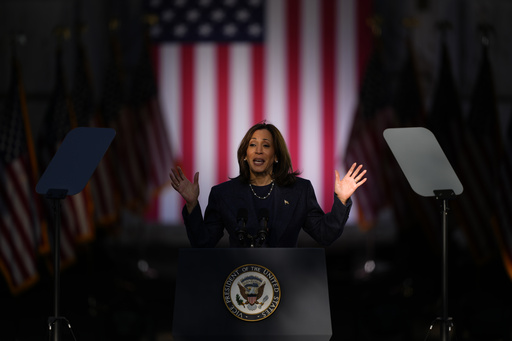
WASHINGTON — As the presidential race heats up in crucial Pennsylvania, Kamala Harris emphasized the importance of democracy and reproductive rights while campaigning with a former Republican congresswoman. In contrast, Donald Trump created buzz by serving French fries at a closed McDonald’s during his visit just a day earlier.
With the 2024 presidential election approaching on November 5, both candidates are adopting vastly different campaign strategies to galvanize their respective support bases. Their approaches could either prove to be strategically sound or potentially misguided.
Trump’s campaign is moving away from appealing to moderate voters and is instead focused on rallying his loyal supporters. His strategy aims to mobilize less frequent voters, particularly young men of various backgrounds, through provocative statements and high-visibility events designed to capture online attention.
On the other hand, Harris is tapping into a more conventional campaign strategy aimed at undecided voters, particularly moderate individuals, college-educated suburbanites, and women across various education levels. Harris is especially focusing on Republican women who may have backed Nikki Haley in the GOP primaries but feel disillusioned with Trump’s leadership.
“It’s all pieces of a very complex puzzle,” noted senior campaign adviser David Plouffe. “If we could concentrate solely on one voter group, it would be simpler. Instead, we must ensure we resonate with various demographics so they collectively contribute to a winning percentage.”
Conversely, Trump’s campaign simplifies the situation. His aides assert that even with a focus on energizing his core followers, they are not ignoring potential swing voters completely, despite the lack of a tailored message for them.
“There’s a misunderstanding of what drives these voters,” stated Trump’s political director James Blair. “The economy is top of mind. Many believe their situation has worsened over the last four years. Thus, the bigger question is: Who can fix this?”
The contrasting strategies are a reflection of the candidates’ personalities and policy viewpoints. Harris, a former senator from California aiming to be the first female president, has expressed a commitment to including a Republican in her administration while emphasizing the safeguarding of democracy, reproductive rights, and support for the middle class. In parallel, Trump has promised to champion the working-class agenda but also hinted at potential retribution against political adversaries through an administration populated by loyal supporters.
Both teams recognize that the election outcome is heavily dependent on seven key swing states—Michigan, Pennsylvania, Wisconsin, Arizona, Georgia, Nevada, and North Carolina—where the political landscape remains consistently competitive as Election Day draws near.
A Harris adviser, speaking off the record, remarked that the situation in these states remains “terrifyingly close.”
Trump’s reluctance to pivot towards moderate voters is evident in his rhetoric, as he speaks primarily to his steadfast base. His rallies feature derogatory remarks and stark warnings about “enemies within.” He has recently suggested that Democrats, including former House Speaker Nancy Pelosi, pose a greater threat to the country than foreign powers like China or Russia.
Furthermore, Trump has bypassed opportunities to engage with traditional audiences, opting instead for interviews and appearances on platforms that cater to younger demographics, particularly working-class Black and Hispanic men, who traditionally have lower voting rates and lean Democratic.
As part of his aggressive outreach, Trump has participated in high-profile events such as mixed martial arts fights and football games to connect with audiences outside the standard political sphere.
One attendee, 28-year-old Black Republican Josh Rouse, explained that he has only recently become interested in politics, having voted for Trump in 2020. “At the end of the day, we’re all people, no matter our background,” Rouse commented after attending a Trump rally. “He talks to everyone.”
Trump has also seized on non-political events to generate buzz, like his McDonald’s visit, which aimed to challenge Harris’ past employment at the franchise. His agenda includes stops in Democratic-dominated states, strategically capitalizing on media interest to reach swing-state audiences.
Harris, fueled by substantial financial backing, is conducting both in-person campaigns and an extensive door-to-door outreach initiative, employing targeted digital advertisements to connect with certain voter groups. Her team estimates that around 10% of voters in battleground states remain persuadable, urging them to keep making a case for their support right up until Election Day.
Harris’ campaign is actively working to attract college-educated suburban women who are alienated by Trump’s inflammatory comments. Even modest changes in voter sentiment in swing states could drastically alter the electoral outcome.
Her team quickly produced ads that spotlighted Trump’s description of the January 6 insurrection as “a day of love,” while Harris is visiting key areas like Michigan and Pennsylvania alongside Republican figures like Liz Cheney, who have vocally opposed Trump.
Scheduled events include a visit to Houston to engage with women affected by strict abortion laws, as the conversation around reproductive rights continues to reverberate following the Supreme Court’s reversal of Roe v. Wade. Most of the outreach takes place in states like Georgia, where abortion restrictions are similarly enforced.
Political independent Nicolette Milholin expressed growing concern over democracy at a recent Harris event, saying, “We’re facing a scenario where one party is striving for a family dynasty, while the other, represented by Kamala Harris, focuses on the interests of all Americans.”
